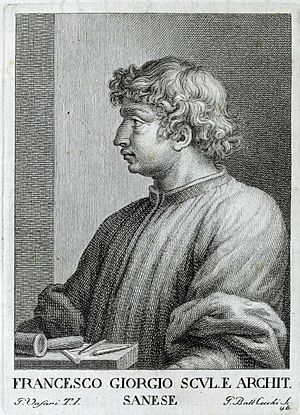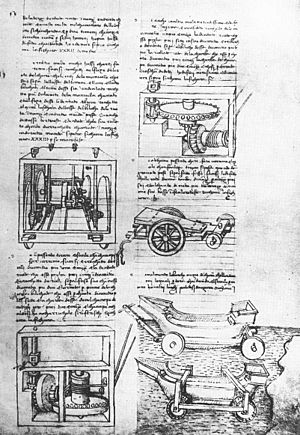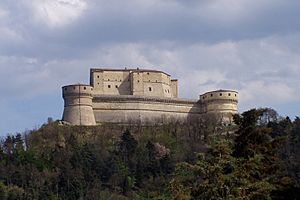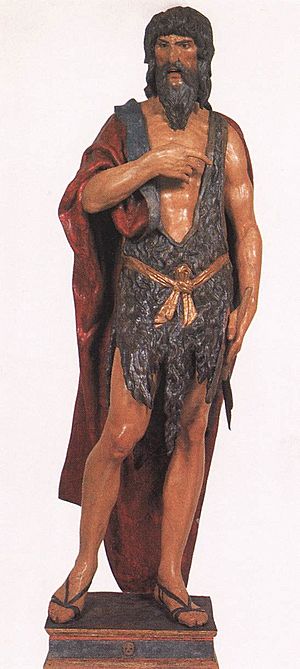Francesco di Giorgio Martini facts for kids
Francesco di Giorgio Martini (1439–1501) was a super talented Italian artist and engineer from the Renaissance period. He was an architect, an engineer, a painter, a sculptor, and even a writer! He was known for his amazing ideas about architecture. People called him one of the most interesting architects of his time.
As a military engineer, he designed and built nearly seventy fortifications (stronghold buildings) for Federico da Montefeltro, who was the Count (and later Duke) of Urbino. He built city walls and some of the very first star-shaped forts. These forts were really advanced for their time!
Francesco was born in Siena, Italy. He learned to paint from an artist named Vecchietta. When he painted scenes for large wooden chests called cassoni, he didn't just show happy wedding parades. Instead, he painted huge, empty city spaces that looked perfect and symmetrical, using perspective to make them look deep and realistic.
He also wrote an important book called Trattato di architettura, ingegneria e arte militare (which means Treatise on Architecture, Engineering, and Military Art). This was one of the first books of its kind in the 1400s. He worked on it for many years, and it was passed around as a handwritten book. Even Leonardo da Vinci had a copy and wrote notes in it! Francesco's ideas in this book, like new ways to design staircases, were very ahead of their time and influenced architects for years to come. He also wrote about the "ideal" city, which he imagined as a star shape, much like his famous star forts.
Towards the end of his career, Francesco di Giorgio became the main architect for the Duomo di Siena (Siena Cathedral). You can still see his bronze angels on the main altar there. Some of the beautiful marble floor designs in the cathedral are also thought to be his work. He also designed the church of San Sebastiano in Vallepiatta in Siena.
One of Francesco di Giorgio's paintings, "Madonna and Child with 2 Angels," can be seen at the Lowe Art Museum in Coral Gables, Florida.
Contents
Biography
Early Life and Training (1439–1470)
Francesco Maurizio di Giorgio di Martino was born in Siena in 1439. His father sold poultry. We don't know much about his childhood, but people believe he learned art from Vecchietta. This is because Francesco's early paintings look a lot like his teacher's style. The first time we find a record of his work is in 1464. He was 25 years old and was paid for a statue of John the Baptist.
He got married twice. His first wife, Cristofana, sadly died soon after they married in 1467. In 1469, he married Agnese. During these years, Francesco shared an art studio and worked with another artist named Neroccio di Bartolomeo de' Landi.
Early Work in Siena (1471–1475)
Francesco di Giorgio's first years as a professional artist, architect, and engineer were very busy. He worked on many different projects. Besides his art, he and another engineer were hired by Siena to improve the city's aqueduct and fountain system. Their goal was to bring much more water to the city. They successfully made the fountain in the Piazza del Campo bigger and improved other parts of the city's water system by 1473. During this time, Francesco also worked with helpers on a large painting called The Coronation of the Virgin for the Santa Maria della Scala (Siena).
In 1471, records from Siena mention that Francesco and nine other people broke into a Monastery of the Holy Saviour outside the city. They were said to have "behaved dishonorably." They were told to leave the city for three months or pay a fine. Francesco paid the fine.
Working for the Duke of Urbino (1475–1484)
In the mid-1470s, Francesco di Giorgio started working for Federico da Montefeltro, the Duke of Urbino. He created many artworks for the Duke, including a bronze relief sculpture called Deposition from the Cross. He also worked as an architect and engineer for the Duke during a conflict called the Pazzi conspiracy. During the wars between Italian city-states that followed, Francesco built many strong fortifications for the Duke. He continued to work for the Duke's son after Federico da Montefeltro passed away.
Francesco also got important architectural jobs while working for the Duke. One of his most famous buildings is probably Santa Maria delle Grazie al Calcinaio in Cortona. Designing this church was tricky because it was on a very steep hill. But Francesco's amazing engineering and architecture skills allowed him to design a very strong building that is still standing today.
Return to Siena and Later Career (1485–1500)
In 1485, the government of Siena asked Francesco di Giorgio to come back to his hometown. They wanted him to design and build public buildings. He returned in 1486 and started getting a yearly salary to be the official city engineer. In this job, he would check all engineering projects throughout Siena. Francesco also created art for the city, like the angel sculptures that hold candles on the altar at the Opera del Duomo.
This was a very successful time for Francesco. Many rulers of different city-states, especially Siena and Urbino, wanted his skills and knowledge. His tax papers from 1488 show that he was wealthy and had six children.
In 1490, the government of Milan asked him to create a model for the dome of the Milan Cathedral. This project took him to the cathedral site, where he met Leonardo da Vinci. Leonardo had also been hired to give advice on the building. Francesco gave helpful advice to the builders of the cathedral and was paid well for his work.
His skills as a war engineer were needed again during the Italian War of 1494–98. He worked for Ferdinand II of Naples. He used tunnels and explosives in a new way, which is considered an early use of mining technology in warfare.
In 1499, Francesco di Giorgio was chosen to be the capomaestro (master builder) of the Opera del Duomo.
Death (1501)
Francesco di Giorgio passed away at age 62 in 1501 or early 1502. He had retired to the countryside outside Siena in mid-1501. His wife spent much of the rest of her life dealing with legal issues about his estate.
See also
 In Spanish: Francesco di Giorgio para niños
In Spanish: Francesco di Giorgio para niños
- Taccola, Sienese Renaissance engineer







